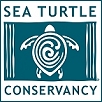Loggerhead turtles off the southeastern United States are an important component of a complex of turtles representing the progeny of multiple rookeries (Bowen et al 1993, Sears et al 1995, Turtle Expert Working Group 2000, SCDNR Unpublished Data). While access to adult female turtles on nesting beaches is common, access to juvenile turtles is relatively limited because of the expense involved in conducting in-water surveys necessary to collect them. Consequently, less is known about the biology and ecology of these turtles than adult females. For example, while movement patterns of nesting females have been studied in some detail, the movement patterns of ocean-going juveniles and adult males remain poorly understood (Turtle Expert Working Group, 2000).
During the summers in 2000-2003, the SCDNR and the UGA Marine Extension Service conducted a regional trawl survey for sea turtles in waters 15-40m deep between Winyah Bay, SC, and St. Augustine, FL (Maier et al. 2004). Turtles were primarily collected using randomized, fishery-independent sampling; however, fishery-dependent sampling (i.e., riding along as observers aboard commercial shrimp trawlers) was also utilized. Of 936 loggerhead collections, only 12 represented re-encounter events; however, catch-per-unit effort during this sampling was nearly 10 times greater than some in-water surveys conducted 10-20 years earlier (Maier et al. 2004). When recaptured, loggerheads were generally observed within 10 km of where released 1-3 years earlier.
Due to the lack of conclusive data regarding the seasonal residence patterns of juvenile loggerheads in coastal waters of the SE USA, over-wintering locations for turtles encountered in this area, and the re-migration rates (assuming these turtles leave for the winter) to coastal waters of the SE USA, it is uncertain whether low tag-recapture rates during the 2000-2003 survey represent high migration out of the area or a dilution of tagged turtles in a sea of unmarked turtles.
To help address these issues, the first of a proposed three year satellite telemetry study of the distributional patterns of juvenile loggerheads in coastal waters near Charleston, SC, was initiated in May 2004. Two juvenile loggerhead sea turtles were released in June and four juvenile loggerheads were released in August. In 2005, six juvenile loggerheads were released in May and six juvenile loggerheads were released in August, with one of these turtles having been caught in May and rehabilitated at the SC Aquarium until August. In 2006, six juvenile loggerheads (maps linked below) were released in May.
   |
For more information on sea turtles, check out the Sea Turtles Information section of our website.
Click on the turtle’s name to see a map of its movements.
BILL – Juvenile loggerhead sea turtle (65.5 cm SCLmin; sex and haplotype TBD) caught during 15-min trawl at index station in Charleston Harbor Entrance Channel. Tagged and released with Telonics ST-20, Model A-2010. Duty cycle continuous on with saltwater switch; expected to last over one year. Dive cycle and water temperature data will be collected in addition to lat/lon.
BRIAN – Juvenile loggerhead sea turtle (70.2 cm SCLmin; sex and haplotype TBD) caught during 15-min trawl at index station in Charleston Harbor Entrance Channel. Tagged and released with Telonics ST-20, Model A-2010. Duty cycle continuous on with saltwater switch; expected to last over one year. Dive cycle and water temperature data will be collected in addition to lat/lon.
DAVID – Juvenile loggerhead sea turtle (67.4 CLmin; sex and haplotype TBD) caught during 15-min trawl at index station in Charleston Harbor Entrance Channel. Tagged and released with Telonics ST-20, Model A-2010. Duty cycle continuous on with saltwater switch; expected to last over one year. Dive cycle and water temperature data will be collected in addition to lat/lon.
JB – Juvenile loggerhead sea turtle (59.6 cm SCLmin; sex and haplotype TBD) caught during 15-min trawl at index station in Charleston Harbor Entrance Channel. Tagged and released with Telonics ST-20, Model A-2010. Duty cycle continuous on with saltwater switch; expected to last over one year. Dive cycle and water temperature data will be collected in addition to lat/lon.
RANDY – Juvenile loggerhead sea turtle (69.3 cm SCLmin; sex and haplotype TBD) caught during 15-min trawl at index station in Charleston Harbor Entrance Channel. Tagged and released with Telonics ST-20, Model A-2010. Duty cycle continuous on with saltwater switch; expected to last over one year. Dive cycle and water temperature data will be collected in addition to lat/lon.
More detailed information about the study can be obtained from the Marine Resources Division, South Carolina Department of Natural Resource.
A project of the South Carolina Marine Resources Research Institute. This study, funded by NOAA Fisheries, represents an extremely collaborative effort between the South Carolina Department of Natural Resources, the University of Georgia Marine Extension Service, and the following organizations and institutions: College of Charleston,Grice Marine Biology Laboratory; University of South Carolina; Medical University of South Carolina; Clemson University; NOAA/National Institute of Standards and Technology; NC State University, College of Veterinary Medicine; Duke University; University of Georgia, College of Veterinary Medicine; University of Hawaii; Greiner North America. Maps created by the Sea Turtle Survival League.